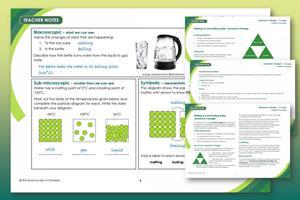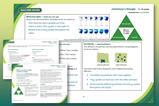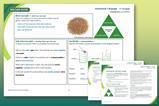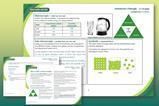Use Johnstone’s triangle to help learners describe and visualise water as it changes state using the particle model
Substances can exist in different states and can change between states at specific temperature points.
-

Download this
Use this student worksheet to introduce melting and boiling points at three different conceptual levels as learners observe water changing state.
View and download more Johnstone's triangle worksheets
Learning objectives
- Describe what happens to a substance when it is heated or cooled in terms of state changes.
- Use melting and boiling point information to work out the state of a substance at a given temperature.
How to use Johnstone’s triangle
Use Johnstone’s triangle to develop learners’ thinking about scientific concepts at three different conceptual levels:
- Macroscopic: what we can see. Think about the properties that we can observe, measure and record.
- Sub-microscopic: smaller than we can see. Think about the particle or atomic level.
- Symbolic: representations. Think about how we represent chemical ideas including symbols and diagrams.
For learners to gain a deeper awareness of a topic, they need to understand it at all three levels.
When introducing a topic, do not try to introduce all of the levels of thinking at once. This will overload working memory. Instead complete the triangle over a series of lessons, beginning with the macroscopic level and introducing other levels, in turn, once secure.
All of the levels are interrelated, for example, learners need visual representation of the sub-microscopic in order to develop mental models of the particle or atomic level.
Further reading
Read more about how to use Johnstone’s triangle in your teaching with these articles:
- Develop deeper understanding with models
- Improve students’ understanding with Johnstone’s triangle
- Practical ideas for using Johnstone’s triangle
Norman Reid’s book The Johnstone Triangle: The Key to Understanding Chemistry provides an more in-depth overview, the first chapter is available to read online.
Teacher demonstration
Use this demonstration of the melting and boiling of water to encourage learners to observe and describe the macroscopic changes of state that are occurring.
Equipment for teacher
- Melting ice cube on a watch glass
- Boiling kettle
Method
- Place an ice cube on a watch glass and observe it melting. You may wish to make use of a visualiser to allow for whole-class observation.
- Add water to a kettle and switch it on to boil the water.
- Learners write their observations in the ‘Macroscopic’ section of the Johnstone’s triangle worksheet.
Scaffolding
It is important to share the structure of the triangle with learners prior to use. Tell them why you want them to use the triangle and how it will help them to develop their understanding. Use an ‘I try, we try, you try’ approach when you are introducing Johnstone’s triangle for the first time.
Next steps
To further develop learners’ thinking in all areas of Johnstone’s triangle, try our Developing understanding of melting and boiling worksheet. This includes icons in the margin referring to the conceptual level of thinking needed to answer the question.
Downloads
Melting and boiling Johnstone's triangle student sheet
Handout | PDF, Size 0.26 mbMelting and boiling Johnstone's triangle teacher notes and answers
Handout | PDF, Size 0.3 mbMelting and boiling Johnstone's triangle student sheet
Editable handout | Word, Size 0.76 mbMelting and boiling Johnstone's triangle teacher notes and answers
Editable handout | Word, Size 0.77 mb























No comments yet